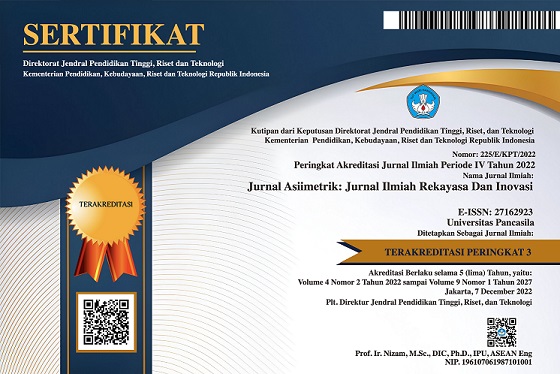Analisis Motor Listrik Tipe Synchronous dengan Metode Komputasi
Abstract views: 672 | pdf downloads: 676
Abstract
In the current technological development, the electric motor is the most popular in various industrial applications. Electric motors today have evolved very quickly and have a significant impact on the lives of the wider community. The use of environmentally friendly and efficient energy is one of the reasons why this motorbike has become a pioneer of technological advances, especially in the automotive world. This research focuses on conducting a comprehensive analytical study on one type of electric motor, namely synchronous because it is widely applied in various conditions today. The analysis was carried out using a computational method by applying the finite element as a method of solving the magnetic field case involving Maxwell's equations and its impact on the torque generated in this synchronous motor. From the computation results, it is found that this synchronous motor does have a high torque when the magnetic field flux works constantly at 0.015 Wb. With an average torque generated by this synchronous motor of 1.5 kW.
References
Benfriha, E. dkk. (2019) ‘Nonlinear adaptive observer for sensorless passive control of permanent magnet synchronous motor’, Journal of King Saud University-Engineering Sciences. Elsevier.
Cha, K.-S. dkk. (2020) ‘Wound field synchronous motor with hybrid circuit for neighborhood electric vehicle traction improving fuel economy’, Applied Energy. Elsevier, 263, p. 114618.
Chen, L. dkk. (2020) ‘A variable-order fractional proportional-integral controller and its application to a permanent magnet synchronous motor’, Alexandria Engineering Journal. Elsevier, 59(5), pp. 3247–3254.
Krishnan, R. (2017) Permanent magnet synchronous and brushless DC motor drives. CRC press.
Li, Y., Zhou, Y., dkk. (2020) ‘Dead-beat control of permanent magnet synchronous motor based on extended voltage vectors set’, Energy Reports. Elsevier, 6, pp. 1377–1382.
Li, Y., Qin, Y., dkk. (2020) ‘Model predictive torque control for permanent magnet synchronous motor based on dynamic finite-control-set using fuzzy control’, Energy Reports. Elsevier, 6, pp. 128–133.
Maciejewski, I. dkk. (2020) ‘Vibration control of an active horizontal seat suspension with a permanent magnet synchronous motor’, Journal of Sound and Vibration. Elsevier, 488, p. 115655.
Nakamura, T. dkk. (2020) ‘Quantitative characterization of nonlinear impedance and load characteristic of 50-kW-class fully superconducting induction/synchronous motor’, Physica C: Superconductivity and its Applications. Elsevier, 578, p. 1353662.
Ortega, R. dkk. (2021) ‘A globally exponentially stable position observer for interior permanent magnet synchronous motors’, Automatica. Elsevier, 125, p. 109424.
da Silva, P. C. dkk. (2020) ‘Reduction of synchronous reluctance motor currents with minimization of direct and cross saturation magnetic model’, ISA transactions. Elsevier.
Sridhar, C. (2020) ‘Fault diagnosis of three-phase electrically-excited synchronous motor by using adaptive threshold algorithm’, Materials Today: Proceedings. Elsevier.
Xu, J. dkk. (2020) ‘A new type of sinusoidal suspension winding Consequent-pole Bearingless Permanent Magnet Synchronous Motor’, Energy Reports. Elsevier, 6, pp. 914–920.
Xu, Y. dkk. (2020) ‘Reduction method of high-frequency audible PWM noise for three-phase permanent magnet synchronous motors’, Energy Reports. Elsevier, 6, pp. 1123–1129.
Yan, X. dkk. (2020) ‘Virtual synchronous motor based-control of Vienna rectifier’, Energy Reports. Elsevier, 6, pp. 953–963.
Yang, Y. dkk. (2020) ‘Efficiency improvement of permanent magnet synchronous motor for electric vehicles’, Energy. Elsevier, 213, p. 118859.
Zhang, S. dkk. (2020) ‘Bursting oscillations and bifurcation mechanism in a permanent magnet synchronous motor system with external load perturbation’, Chaos, Solitons & Fractals. Elsevier, 141, p. 110355.


























